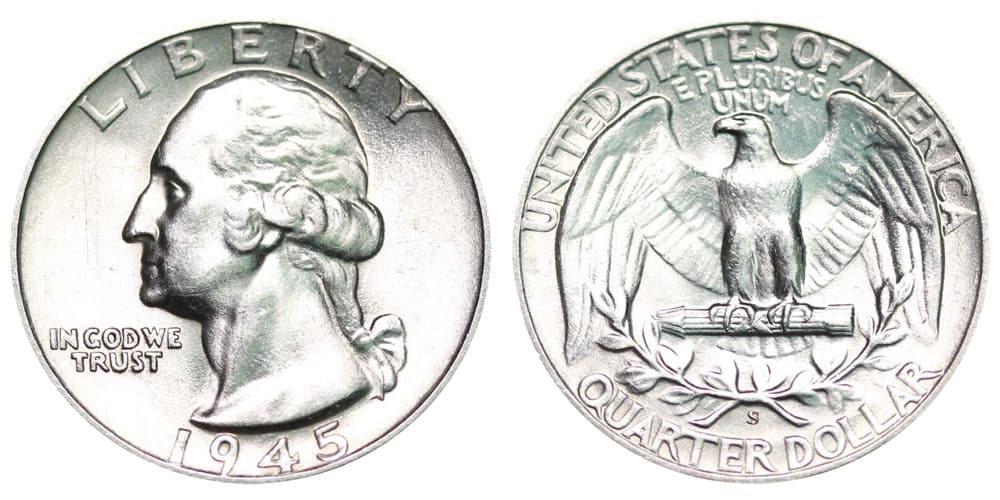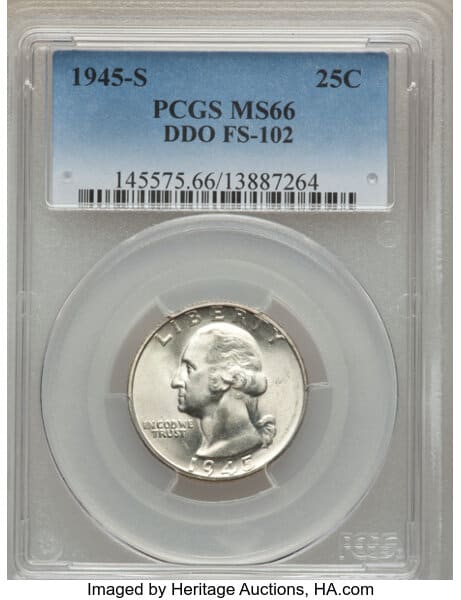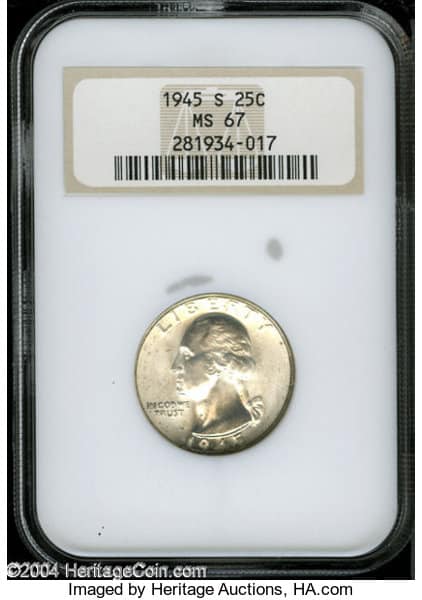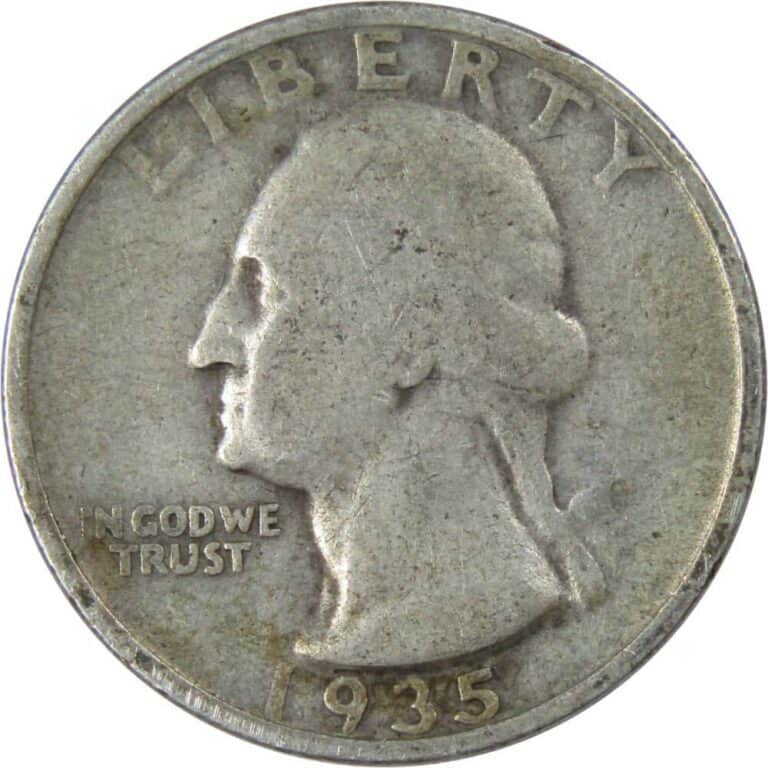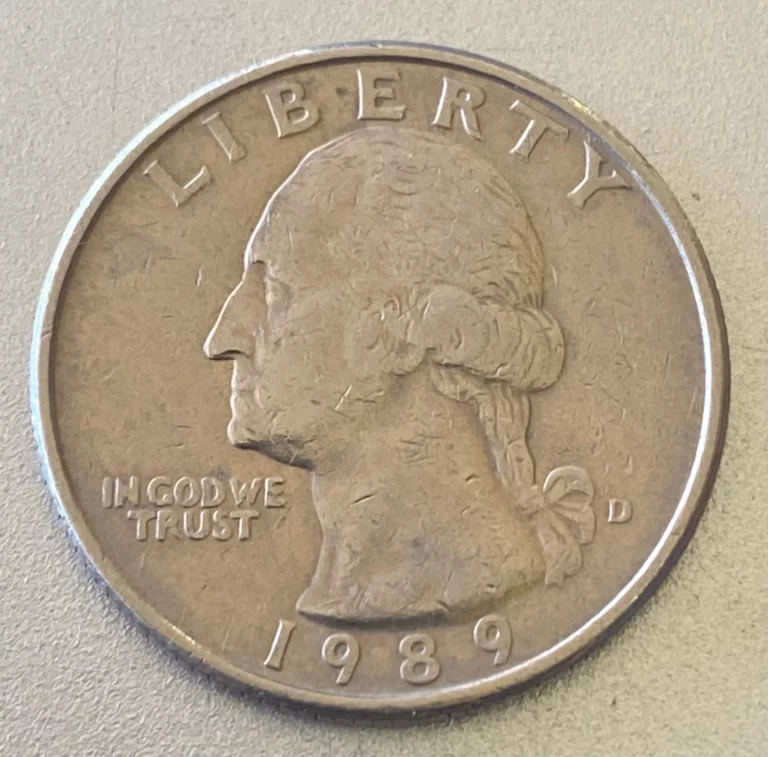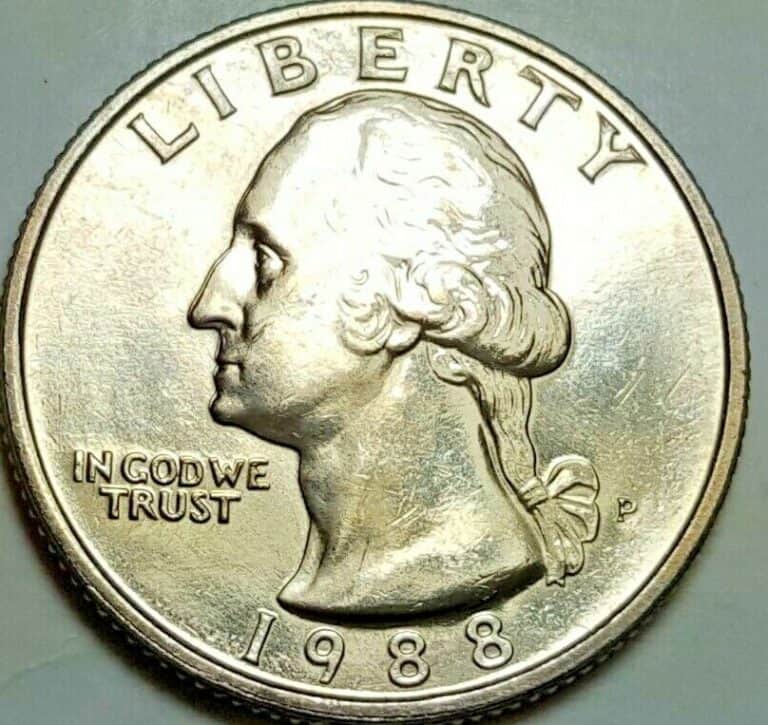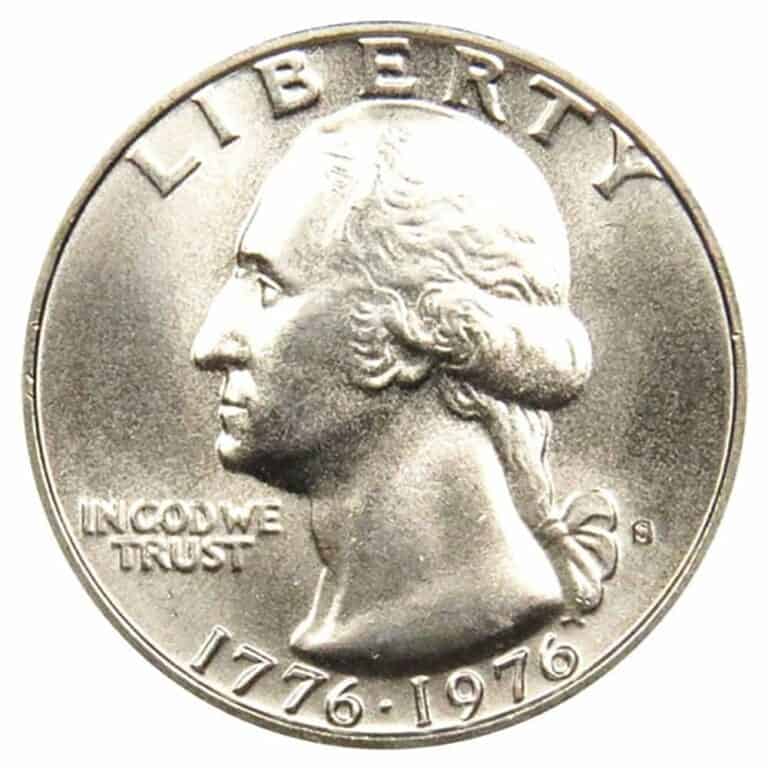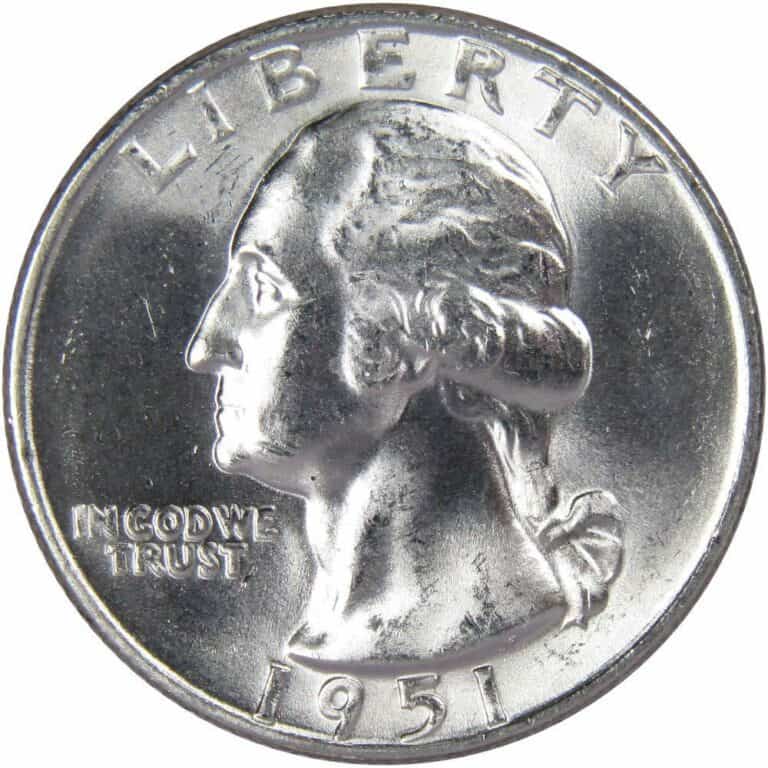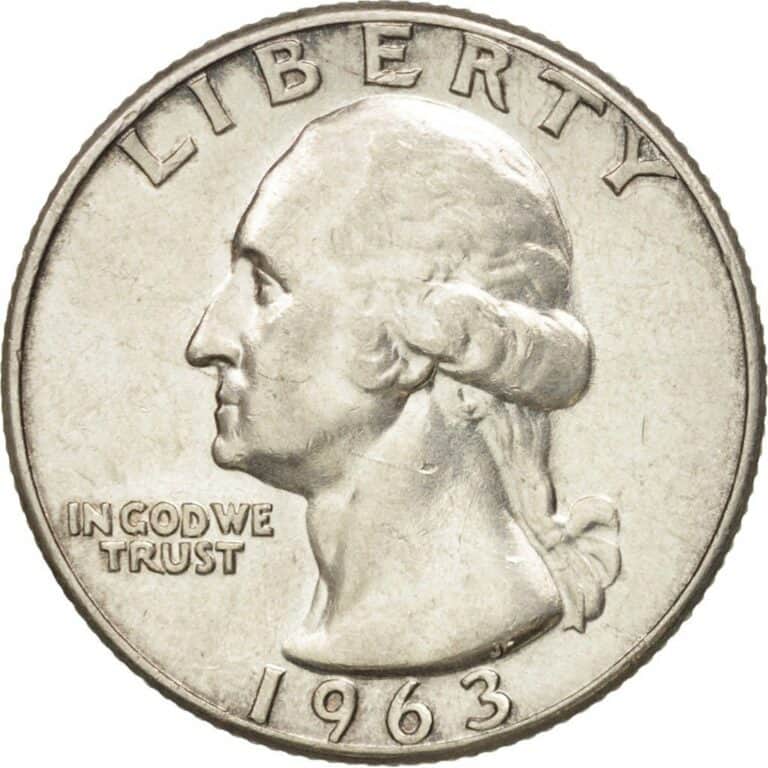1945 Quarter Value: How Much Is It Worth Today?
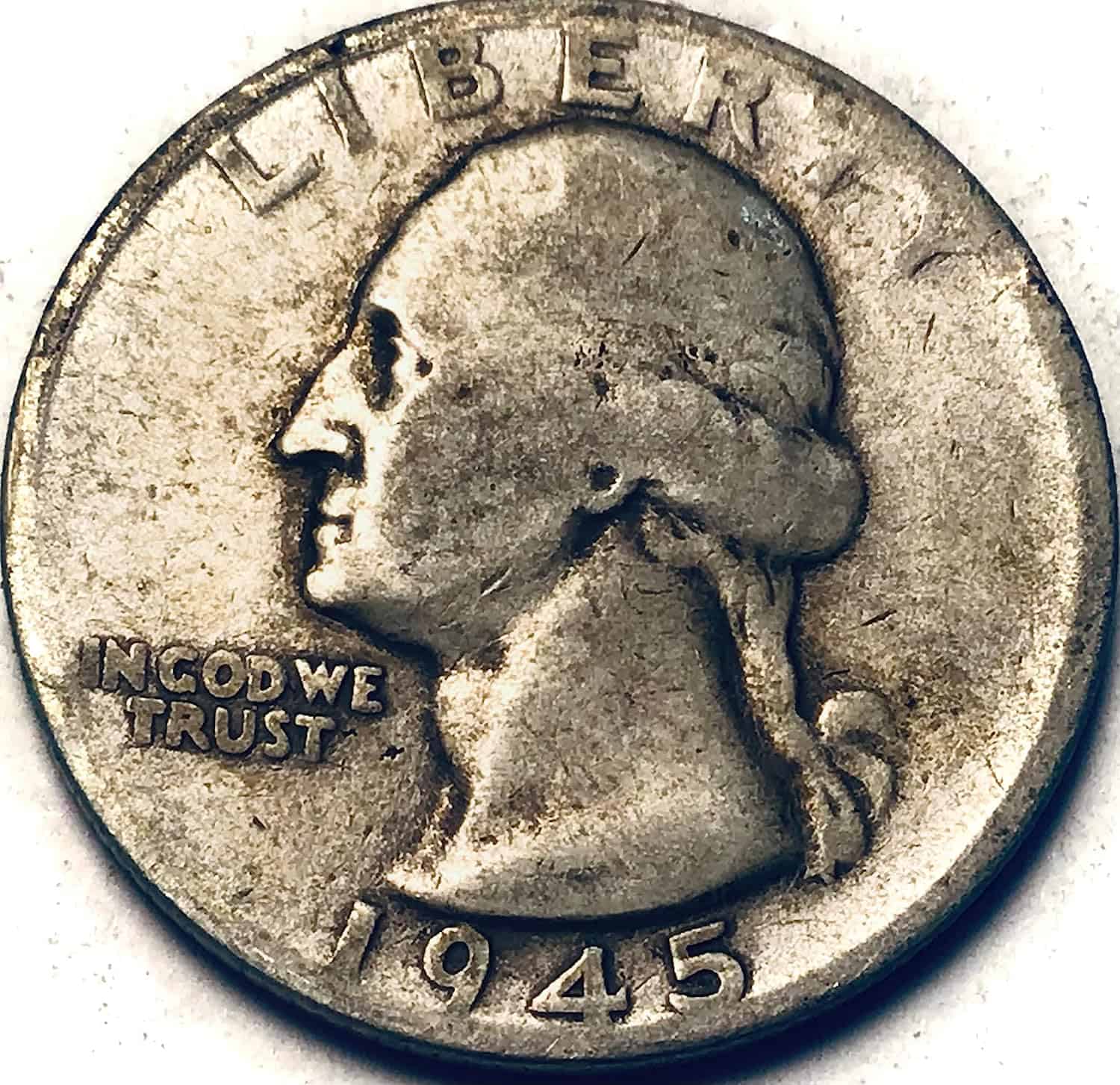
Washington quarters are easily one of the most collectible coins in American history. Not only do they hold enormous historical significance, but many of these quarters survive in mint condition and go on to sell for hundreds, if not thousands, of dollars at auction.
The 1945 quarter is an incredibly fascinating coin to have. Not only is one a post-World War 2 coin, but its high silver content makes it a lucrative investment in virtually every mint state.
But as you might know, some 1945 quarters have auctioned for thousands of dollars. So what exactly can make a 1945 quarter truly sparkle?
This article will explore the 1945 quarter value in detail. We’ll cover all the different variations of this coin type and highlight unique features they might have. Using auction data, we’ll also help grade and evaluate the potential your 1945 quarter might have at auction.
1945 Quarter value chart |
||||
| Mint Mark | Good
(G-4) |
Extremely Fine | Uncirculated
(MS-65) |
Uncirculated
(MS-67)
|
| 1945 No Mint Quarter Value | $9 | $9 | Up to $45 | Up to $16,450 |
| 1945 D Quarter Value | $9 | $9 | Up to $220 | Up to $20,400 |
| 1945 S Quarter Value | $9 | $9 | Up to $44 | Up to $7,200 |
1945 No Mint Quarter Value
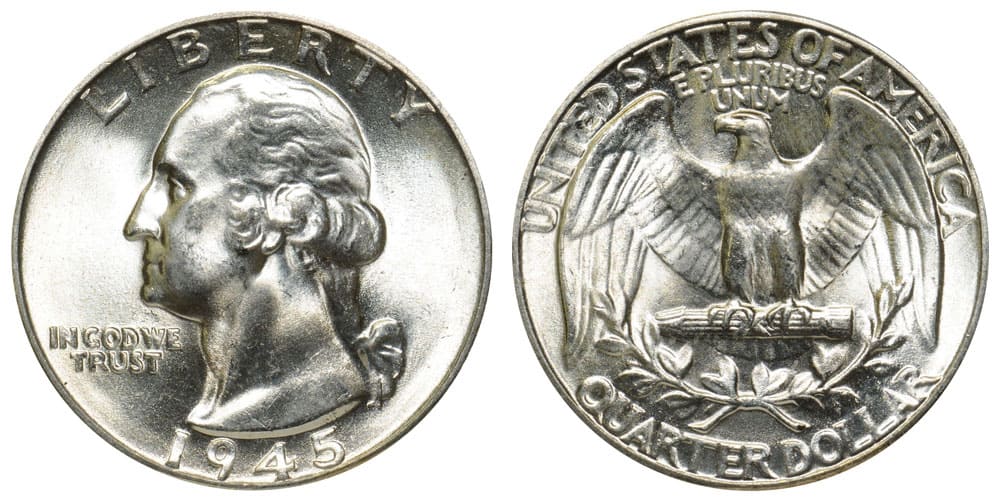
The mint in Philadelphia easily produced the most Washington quarters in 1945, at an impressive 74,372,000. You can identify them by the absence of a mint mark on the coin’s reverse.
The coin’s design has remained unchanged since its initiation in 1932. Initially, Washington quarters were designed to help celebrate 1st president George Washington’s bicentennial birthday, replacing the much loved Standing Liberty quarter.
The winning design was chosen through a highly competitive open contest, whose only rule was that the obverse must feature a portrait of Washington. American sculptor John Flanagan was deemed the winner, using Jean-Antoine Houdon’s famous bust of Washington as inspiration for the obverse side.
The obverse features the now-iconic text ‘In God We Trust’ and the word ‘Liberty’ surrounding Washington.
The reverse, which Flanagan also designed, depicted an American eagle with wings spread out, clutching a bundle of arrows and two olive branches. This design symbolized America’s ability to defend itself and strive for peace with its allies. The quarter’s mint mark was
Since its release, the Washington quarter has become a top-rated and patriotic coin to own. Until 1964, the quarters were primarily made of 90% silver and 10% copper, making them quite expensive to produce and having a much higher melting value than their face value of 25 cents.
To combat counterfeiting, the 1945 quarter has reeded edges that prevent people from taking silver filings from the coin to produce replicas. If a coin had shaven edges, people would know it was tampered with.
Additionally, the 1945 quarter had an exact weight of 6.25 grams and a diameter of 24.3mm, making it easily detectable to machines then.
Because of the massive production numbers, many experts regard the 1945 no mint quarter as relatively common and low-value, especially if in average condition. Low-grade coins will only fetch about $9 at auction, helped in part by their high silver composition.
But high mint-state quarters are always in high demand, and the 1945 quarter is no exception. MS65+ grade no mint quarters can go from $45 to a few thousand dollars, depending on the features and coin qualities.
The highest recorded sale of a 1945 no mint quarter was $16,450 in 2015. This sale was so high because the quarter scored an unmatched MS68+ and retained stunning luster and well-struck details.
1945 D Quarter Value
Denver produced the least amount in 1945 quarters, at just 12,341,600. This is quite a rare occurrence, as Denver usually kept production levels close to Philadelphia.
A reason behind this drop in production was the position America found itself in following the end of World War 2. As the US economy was recovering, the US Mint decided to lower the production of coins, especially silver-based coins like quarters.
As their name suggests, you can identify a 1945 D quarter by their signature ‘D’ mint mark on the coin’s reverse. Like other quarters of the era, they were made with 90% silver, meaning they have a higher melt value of $4.35. This makes the coins an excellent investment, irrespective of coin quality.
Like other higher face-value coins, the 1945 D quarter had reeded edges to prevent forgeries from entering circulation. The coin had a set weight of 6.25 grams and a diameter of 24.3mm, which helped vendors examine and analyze coin authenticity.
Despite their significantly lower circulation rate, 1945 D quarters are similar to other varieties’ values. Average quarters will still be worth around $9 in good or fine condition. Even in higher-mint states, their value doesn’t exceed a few hundred dollars.
One possible reason behind this market shift is that the 1945 D quarter is said to have been incredibly well made. Per coin auction site PCGS, 19045 quarters often have vivid details and luster, making high mint-state conditions feel generic.
There are exceptions to these trends, and certain 1945 d quarters have been known to break auction expectations. The coin becomes quite valuable in higher MS67 and MS68, regularly selling for thousands of dollars. A 1945 D quarter sold for an impressive $20,400 in 2021 and is said to have “superior technical quality” and outstanding eye appeal.
1945 S Quarter Value
The final variety is the 1945 S quarter, minted in San Francisco. This mint produced 17,004,001 quarters this year, making them the second-largest producer by quite a margin.
You can easily spot these coins by their signature ‘S’ mint mark on the reverse. It was made with 90% silver and 10% copper, making it quite an expensive coin to produce.
While San Francisco generally produced proof copies of coins to tap into the growing collector’s market in America, 1945 quarters were made with such high quality that other quarters in the same year had the same high-quality appearance. Many coins still retain their details, luster, and sparkle over time.
As such, it can be challenging for high-mint coins to stand out at auction. Good or fine 1945 S quarters will fetch the expected $9, with higher MS coins barely breaking the hundred-dollar mark.
Another potential reason for this low value is that quarters from 1944 and 1946 had unique error variations on their coins, respectively. These occurrences might reduce the appeal and excitement the 1945 coins have in the eyes of collectors.
The highest recorded sale for a 1945 S quarter is a modest $7,200. The coin in question scored an MS67 and was said to have beautiful iridescent coloring, total frost, and surface details.
1945 Quarter Grading
Grading your 1945 quarter is the first step in discovering its actual value. Collectors often will use the Sheldon coin grading system to do this. It’s a 70-point scale that classifies coins based on quality, color, luster, and more.
Rare 1945 Quater Error List
An error can transform the value of your 1945 quarter in an instant. That’s because it can become one-of-a-kind in the eyes of a collector.
Unfortunately, there are not many known errors with 1945 quarters. Most variations are not errors but imperfections, resulting in lower grading. That said, there are exceptions, and some common errors to keep an eye out for include:
1945 Quarter Double Die Error
The double die error is among the most common mistakes across all 1945 quarters and is when the quarter stays in place after striking, only to be hit again.
Sometimes, this error results in very detailed, pronounced designs on the coin. If the coin moves between strikes, it can also result in a distorted “mirror” effect, where two designs overlap.
The value of this error ultimately depends on the severity of the double images. On average, it can sell for a couple hundred, sometimes thousands, dollars at auction, so long as the coin’s overall condition is in good health.
This 1945 S quarter, for example, sold for $1,527 in 2015, with a noticeable doubling around the text and figures on the coin’s obverse side.
1945 Quarter with clipped error
Clip errors result from coins struck on damaged planchets. The coin will have a “bite mark” taken off it and can be straight, curved, irregular, or bowtied in shape.
Because of the high silver composition, 1945 quarters are often re-melted and re-struck rather than allowed to enter circulation damaged. But there are some instances where 1945 quarters have surfaced with clip errors.
Unfortunately, this error doesn’t add that much value to coins, as evident in this 1945 S quarter with straight clip error, which only sold for $41 in 2005.
1945 Quarter with off-center errors
Off-centering is a standard error found across many different coin series. It occurs when the coin and stamp aren’t correctly aligned, making the portrait or text skewed.
Because of its higher silver composition, not many 1945 quarters entered circulation with faults, and there isn’t enough market data to show the actual value of this error. But generally, collectors measure the value in percentages, with higher numbers fetching a higher premium.
10% off-center errors may sell for $30 in uncirculated conditions, while more extreme errors like 90% off-centering can add $200 or higher to the coin’s value.
1945 Quarter with Broadstruck error
Like other coins of that era, minters used a series of collars and standardized stamps to mass-produce 1945 quarters, helping ensure coins were the same diameter and weight.
These collars may sometimes become damaged or loose, and the coin would look different than others in the series, resulting in a broadstruck error. This 1945 S quarter, for instance, sold for $253 in 2004 and is noted to have incredibly “weak” detailing on the date of the coin.
1945 Quarter FAQ
What makes a 1945 Quarter rare?
Because they were made in their high millions, the 1945 quarter isn’t that rare and can be found regularly in auctions worldwide.
These quarters were well-made, meaning there was no short supply of high mint-state coins. Only coins with an MS67+ can be considered rare and valuable.
What material is a 1945 Quarter made from?
Like the quarters before, the 1945 quarter had a composition of 90% silver and 10% copper. This gave the quarter a higher melt value of $4.35, which may continue to rise with the price of silver.
Even in poor condition, the 1945 quarter can be a safe investment because it will almost always be worth more than 25 cents.
What errors exist for the 1945 Quarter?
Errors are known to help transform the value of a coin in an instant. Unfortunately, there were no widespread production errors found in the 1945 quarters. The majority of sales are for generic, well-made coins.
To make matters worse, the years before and after (1944 and 1946) featured prominent quarter errors, making the 1945 quarter appear even more generic.
Which is rarer, a 1945 no mint, D or S Quarter?
Usually, coins with low mint numbers fetch a premium at auction because they are considered. The 1945 quarter is an exception to this rule.
Despite the significant difference in production records, there is no real difference in value between the three varieties of 1945 quarters. The only primary consideration you should have is the coin’s overall condition – not its origin.
What is the highest recorded sale for a 1945 Quarter?
According to coin auction site PCGS, the highest selling 1945 quarter to date was $20,400 in 2019. The coin in question was described as having unparalleled clarity and luster and was in impeccable condition.

